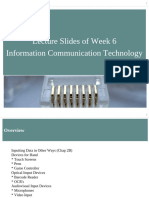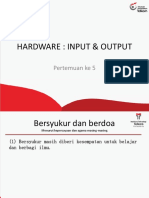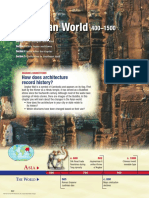Input and Output Devices
Uploaded by
cutestoneInput and Output Devices
Uploaded by
cutestoneInput and Output Devices
Learning Objectives
Identify several types of input and output devices and explain their functions. Describe the characteristics of the input equipment that most users encounter regularlynamely, keyboards and pointing devices. Explain what source data automation is and discuss how scanners and other devices can be used to accomplish it. List several types of multimedia input devices and discuss their purposes.
Learning Objectives, contd.
Describe the characteristics of the output equipment that most users encounter regularlynamely, display devices and printers. Discuss several types of multimedia output equipment. Explain what a multifunction device is and list some advantages and disadvantages of using such a device.
Input and Output
Input devices convert data and programs that people can understand into a form comprehensible to the CPU. Output devices convert the strings of bits used by the computer back into a form that people can understand.
Keyboards
Keyboards can differ in number of keys, key arrangement, types of special keys, and touch.
Function keys enable software packages to be
customized to meet a user's applications needs.
The numeric keypad makes it easy to enter numbers quickly.
Pointing Devices: Mouse
Older mechanical mice move a ball on the bottom of the mouse. Newer optical mice are completely sealed and dont require cleaning. Common mouse operations are clicking, scrolling, and dragging and dropping.
Pointing Devices: Electronic Pens
Electronic pen: an alternative to the mouse to select objects or to write or draw on the screen Devices that use pen input: Graphics tablets Signature capture devices Pen-based computers
Pointing Devices: Touch Screens
Touch screens are used:
When other input devices are impractical When consumer input is required, as in consumer kiosks
Other Pointing Devices
Joystick Trackball Pointing stick Touch pad
Scanners and Related Devices
Source data automation involves collecting data in
machine-readable form as soon as it is generated.
Source data automation is used to convert source documents into digital form and commonly utilizes some type of scanner.
Optical Scanners
Optical scanner: converts hard-copy images of text pages, photographs, and drawings into digital form Types of image scanners: Flatbed Sheet-fed Hand-held Drum Three-dimensional
Optical Readers
Optical marks
Optical characters Optical codes
Magnetic Ink Character Recognition Reader
Magnetic ink character recognition is used primarily with processing checks. Readers can read the special magnetic characters, as well as sort documents by their codes.
Multimedia Input: Digital Cameras
Digital cameras record data onto digital media instead of film. The camera is either connected to a port on the PC or media is inserted into a reader attached to the PC. Software that comes with the camera then allows you to transfer images to the PC and erase media so more photos can be taken.
Multimedia Input: Video Cameras
Video cameras can be used to either record or send
images over the Internet.
Video input can also be obtained by using special hardware to transfer conventional video images to the computer.
Multimedia Input: Audio Input Devices
Voice-input systems convert spoken words to digital data. Music-input systems can record musical input for use with a multimedia presentation or to be edited or combined with other input.
Telephony is the process of performing telephoneoriented tasks using a computer.
Display Devices
Display devices are the most common type of output device. PC displays are commonly called monitors. The cursor, or insertion point, indicates where editing or typing will appear on the display screen.
Size
Most monitors today are about 17 inches wide, measured diagonally. The actual viewing area is typically less than the stated size.
Resolution
Resolution refers to the sharpness of the screen
image.
Images are formed by lighting up tiny dots on the screen called pixels.
Graphics Standards
Computer graphics standards specify such characteristics as the possible resolutions and number of colors that can be used.
Video cards connect the monitor to the PC and
support a particular graphics standard, such as SVGA.
Video cards typically contain video RAM to support the number of colors and resolutions allowed, as well as to help speed up image display.
Color vs. Monochrome Displays
Most color displays are of the RGB type. RGB displays combinations of red, blue, and green light to form other colors.
CRT vs. Flat-Panel Displays
Most desktop display devices use CRT technology, similar to conventional television technology. Flat-panel displays are compact, lightweight, and consume little power. Ideal for notebook computers Most use liquid crystal display (LCD) technology
HDTV
HDTV is a new type of television that supports highresolution digital broadcasts.
All broadcasting is expected to eventually be high definition.
Characteristics of Printers
Print resolution is commonly measured in dots per inch (dpi).
Impact printers use metal hammers to strike a ribbon
or paper.
The large majority of the printers sold today are nonimpact printers. Do not depend on the impact of metal hammers; contain fewer moving parts
Personal Printers: Laser
Laser printers often cost between $200 and $400 and print 5 to 12 pages per minute (ppm), at resolutions of at least 600 dpi. Work similarly to photocopy machines. Are usually black and white, though color laser printers are available.
Personal Printers: Ink-Jet
Ink-jet printers produce images by spraying thousands of droplets of electrically charged ink onto a page. Technology of choice for home users who want to produce affordable, hard-copy color output from desktop systems.
Network Printers
A network printer is shared by several people over a local area network. Line printers print a whole line at a time rather than just a character. Page printers can produce a page of output at a time. Network laser printers are faster and hold more paper than personal versions.
Special Purpose Printers
Photo printers Bar-code printers
Portable printers
Plotters Wide-format ink-jet printers
Label printers
Multimedia Output Devices
Speakers Data and multimedia projectors
Voice-output systems
Multifunction Devices
A multifunction device offers some combination of:
Printing
Copying
Scanning Faxing
You might also like
- Computer Peripheral Devices CSC 225 200l 2024 25 Note 2No ratings yetComputer Peripheral Devices CSC 225 200l 2024 25 Note 27 pages
- Introduction To Computers Module 7 Input and Output S2 21No ratings yetIntroduction To Computers Module 7 Input and Output S2 2125 pages
- 3-CET-MCQs-Computer-Inout-Output DevicesNo ratings yet3-CET-MCQs-Computer-Inout-Output Devices13 pages
- DIT103 Information Technology Hardware and Software HIND104 Computer EnvironmentsNo ratings yetDIT103 Information Technology Hardware and Software HIND104 Computer Environments53 pages
- Module 6 Input and Output Entering Data and Producing InformationNo ratings yetModule 6 Input and Output Entering Data and Producing Information45 pages
- Unit-4[Input and Output Devices]_81db7361-b58f-432f-a76f-c1a4f1fde4aeNo ratings yetUnit-4[Input and Output Devices]_81db7361-b58f-432f-a76f-c1a4f1fde4ae17 pages
- 2. Computer Hardware - Input & Output DevicesNo ratings yet2. Computer Hardware - Input & Output Devices9 pages
- Computer Orgnization: Dr. Chaitali ShahNo ratings yetComputer Orgnization: Dr. Chaitali Shah38 pages
- What Is ICT: Information and Communications Technology (ICT) Is Often Used As An Extended SynonymNo ratings yetWhat Is ICT: Information and Communications Technology (ICT) Is Often Used As An Extended Synonym8 pages
- Introduction To Computing: Manzoor Ali SolangiNo ratings yetIntroduction To Computing: Manzoor Ali Solangi40 pages
- Input Device Definition in Fundamental of Computer ScienceNo ratings yetInput Device Definition in Fundamental of Computer Science13 pages
- 1 Computer Basic Input Devices, Output Devices, System Unit, ProcessorNo ratings yet1 Computer Basic Input Devices, Output Devices, System Unit, Processor58 pages
- Adobephotoshopbasics Session1 HT 130121235928 Phpapp01 PDFNo ratings yetAdobephotoshopbasics Session1 HT 130121235928 Phpapp01 PDF15 pages
- The Asian World: How Does Architecture Record History?No ratings yetThe Asian World: How Does Architecture Record History?38 pages
- FDOT Subassemblies Essentials FDOT Subassemblies EssentialsNo ratings yetFDOT Subassemblies Essentials FDOT Subassemblies Essentials21 pages
- FIRE RETARDANT REPELLENCY - Burlington Military BrochureNo ratings yetFIRE RETARDANT REPELLENCY - Burlington Military Brochure8 pages
- Analysis of Space Norms For Low Cost Buildings Laurie BakerNo ratings yetAnalysis of Space Norms For Low Cost Buildings Laurie Baker17 pages
- Cambridge Ebooks Price List November 2019 USDNo ratings yetCambridge Ebooks Price List November 2019 USD7,227 pages
- Vidyarthiyon Ki Shaikshik Uplabdi Par Shaikshik Tanav Ke Prabhav Ka AdhyayanNo ratings yetVidyarthiyon Ki Shaikshik Uplabdi Par Shaikshik Tanav Ke Prabhav Ka Adhyayan6 pages
- Kasgaard. Neither Head Nor Tail (Dissertation) PDFNo ratings yetKasgaard. Neither Head Nor Tail (Dissertation) PDF278 pages
- How To Die A Good Death Sutta Study Workbook - 5No ratings yetHow To Die A Good Death Sutta Study Workbook - 588 pages
- Book of Jonah CHAPTER 1:1-17 Jonah Thrown Into The SeaNo ratings yetBook of Jonah CHAPTER 1:1-17 Jonah Thrown Into The Sea1 page
- The Analysis of The Victory (A Poetry Analysis)No ratings yetThe Analysis of The Victory (A Poetry Analysis)13 pages
- Pick and Generally Known As Plectrum Instruments? and String With Either Nylon or Steel String. Among The Instruments. Wooden BodyNo ratings yetPick and Generally Known As Plectrum Instruments? and String With Either Nylon or Steel String. Among The Instruments. Wooden Body2 pages
- Simple Past: We Use The Past Tense To Talk AboutNo ratings yetSimple Past: We Use The Past Tense To Talk About3 pages
- Gandhi's Hind Swaraj As Postcolonial Text (Literary Theory Presentation)No ratings yetGandhi's Hind Swaraj As Postcolonial Text (Literary Theory Presentation)5 pages
- Computer Peripheral Devices CSC 225 200l 2024 25 Note 2Computer Peripheral Devices CSC 225 200l 2024 25 Note 2
- Introduction To Computers Module 7 Input and Output S2 21Introduction To Computers Module 7 Input and Output S2 21
- DIT103 Information Technology Hardware and Software HIND104 Computer EnvironmentsDIT103 Information Technology Hardware and Software HIND104 Computer Environments
- Module 6 Input and Output Entering Data and Producing InformationModule 6 Input and Output Entering Data and Producing Information
- Unit-4[Input and Output Devices]_81db7361-b58f-432f-a76f-c1a4f1fde4aeUnit-4[Input and Output Devices]_81db7361-b58f-432f-a76f-c1a4f1fde4ae
- What Is ICT: Information and Communications Technology (ICT) Is Often Used As An Extended SynonymWhat Is ICT: Information and Communications Technology (ICT) Is Often Used As An Extended Synonym
- Input Device Definition in Fundamental of Computer ScienceInput Device Definition in Fundamental of Computer Science
- 1 Computer Basic Input Devices, Output Devices, System Unit, Processor1 Computer Basic Input Devices, Output Devices, System Unit, Processor
- Computer for Kids: Input, Output and Storage DevicesFrom EverandComputer for Kids: Input, Output and Storage Devices
- Adobephotoshopbasics Session1 HT 130121235928 Phpapp01 PDFAdobephotoshopbasics Session1 HT 130121235928 Phpapp01 PDF
- The Asian World: How Does Architecture Record History?The Asian World: How Does Architecture Record History?
- FDOT Subassemblies Essentials FDOT Subassemblies EssentialsFDOT Subassemblies Essentials FDOT Subassemblies Essentials
- FIRE RETARDANT REPELLENCY - Burlington Military BrochureFIRE RETARDANT REPELLENCY - Burlington Military Brochure
- Analysis of Space Norms For Low Cost Buildings Laurie BakerAnalysis of Space Norms For Low Cost Buildings Laurie Baker
- Vidyarthiyon Ki Shaikshik Uplabdi Par Shaikshik Tanav Ke Prabhav Ka AdhyayanVidyarthiyon Ki Shaikshik Uplabdi Par Shaikshik Tanav Ke Prabhav Ka Adhyayan
- Kasgaard. Neither Head Nor Tail (Dissertation) PDFKasgaard. Neither Head Nor Tail (Dissertation) PDF
- Book of Jonah CHAPTER 1:1-17 Jonah Thrown Into The SeaBook of Jonah CHAPTER 1:1-17 Jonah Thrown Into The Sea
- Pick and Generally Known As Plectrum Instruments? and String With Either Nylon or Steel String. Among The Instruments. Wooden BodyPick and Generally Known As Plectrum Instruments? and String With Either Nylon or Steel String. Among The Instruments. Wooden Body
- Gandhi's Hind Swaraj As Postcolonial Text (Literary Theory Presentation)Gandhi's Hind Swaraj As Postcolonial Text (Literary Theory Presentation)
































































































